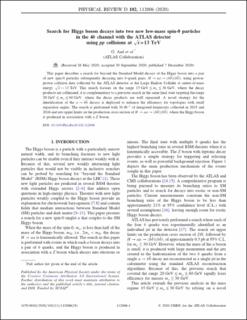Search for Higgs boson decays into two new low-mass spin-0 particles in the 4b channel with the ATLAS detector using pp collisions at √s = 13 TeV
Aad, Georges; Abbott, Brad; Abbott, Dale C.; Abed Abud, Adam; Abeling, Kira; Abhayasinghe, Deshan Kavishka; Abidi, Syed Haider; AbouZeid, Ossama Sherif Alexander; Abraham, Nadine L.; Abramowicz, Halina; Bjørke, Kristian; Bugge, Magnar Kopangen; Cameron, David Gordon; Catmore, James Richard; Garonne, Vincent; Gramstad, Eirik; Heggelund, Andreas Løkken; Hellesund, Simen; Håland, Even Simonsen; Morisbak, Vanja; Oppen, Henrik; Ould-Saada, Farid; Pedersen, Maiken; Read, Alexander Lincoln; Rye, Eli Bæverfjord; Røhne, Ole Myren; Sandaker, Heidi; Vadla, Knut Oddvar Høie; Buanes, Trygve; Djuvsland, Julia Isabell; Eigen, Gerald; Fomin, Nikolai; Lee, Graham Richard; Lipniacka, Anna; Martin dit Latour, Bertrand; Stugu, Bjarne; Træet, Are Sivertsen; Abreu, Henso; Abulaiti, Yiming; Acharya, Bobby S.; Achkar, Baida; Adam, Lennart; Adam-Bourdarios, Claire; Adamczyk, Leszek; Adamek, Lukas; Adelman, Jareed; Adersberger, Michael; Adigüzel, Aytül; Adorni, Sofia; Adye, Tim; ATLAS, Collaboration
Journal article, Peer reviewed
Published version

View/
Date
2020-12-07Metadata
Show full item recordCollections
- Department of Physics and Technology [2161]
- Registrations from Cristin [10402]
Abstract
This paper describes a search for beyond the Standard Model decays of the Higgs boson into a pair of new spin-0 particles subsequently decaying into b-quark pairs, H→aa→(b¯b)(b¯b), using proton-proton collision data collected by the ATLAS detector at the Large Hadron Collider at center-of-mass energy √s=13 TeV. This search focuses on the range 15 GeV ≤ma≤ 30 GeV, where the decay products are collimated; it is complementary to a previous search in the same final state targeting the range 20 GeV ≤ma≤60 GeV, where the decay products are well separated. A novel strategy for the identification of the a→b¯b decays is deployed to enhance the efficiency for topologies with small separation angles. The search is performed with 36 fb−1 of integrated luminosity collected in 2015 and 2016 and sets upper limits on the production cross section of
H→aa→(b¯b)(b¯b), where the Higgs boson is produced in association with a Z boson.
